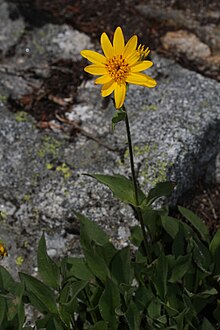| Arnica mollis | |
|---|---|

| |
| Arnica mollis in Henry M. Jackson Wilderness | |
| Conservation status | |
 Secure (NatureServe) | |
| Scientific classification | |
| Kingdom: | Plantae |
| Clade: | Tracheophytes |
| Clade: | Angiosperms |
| Clade: | Eudicots |
| Clade: | Asterids |
| Order: | Asterales |
| Family: | Asteraceae |
| Genus: | Arnica |
| Species: | A. mollis |
| Binomial name | |
| Arnica mollis Hook. | |
| Synonyms | |
Synonymy
| |
Arnica mollis, the soft arnica or hairy arnica, is a perennial herbaceous flowering plant in the family Asteraceae. It is native to Canada (British Columbia, Alberta, Quebec, and the territories) and the United States (Alaska south to Tulare County, California, and Rio Arriba County, New Mexico). There may be a disjunct population of this species in Coös County, New Hampshire. The species grows in subalpine mountain habitat such as meadows and streambanks.
Description
Arnica mollis is a perennial herb producing one or more hairy, glandular, mostly naked stems 15 to 70 centimeters tall. There are 2 to 4 pairs of leaves along mainly the lower half of the stem, each oblong in shape and 4 to 20 centimeters in length.
The inflorescence holds one to seven daisylike flower heads with 10–22 ray florets and yellow disc florets. The fruit is an cypselae with a brownish pappus.
Distribution and habitat
Arnica mollis is found in sections of Canada (Alberta, British Columbia, Quebec, Nunavut, Yukon, Northwest Territories) and the western United States south to Tulare County, California, and Rio Arriba County, New Mexico. There may be a small disjunct population of the species in Coös County, New Hampshire.
According to the Flora of North America, plants of this species typically grow in wet meadows, conifer forests, stream banks and areas with melting snow at elevations of 1,000–4,000 m (3,300–13,100 ft) above sea level.
Conservation
As of December 2024, the conservation group NatureServe listed Arnica mollis as Secure (G5) worldwide. This status was last reviewed on 13 May 2016. At the state and provincial levels, the species is listed as Apparently Secure (S4) in Montana; Vulnerable (S3) in Nevada and Alberta; Possibly Extirpated in the Northwest Territories; and No Status Rank (not assessed) across the rest of the species' range.
Taxonomy
Arnica mollis was first formally named and described by William Jackson Hooker in 1834 in the Flora Boreali-Americana publication.
Etymology
The specific epithet mollis means "soft", referring to the soft hairs on the leaves. In English, this species is known by the common names soft arnica, and hairy arnica.
References
- ^ NatureServe (6 December 2024). "Arnica mollis | NatureServe Explorer". NatureServe Explorer. Arlington, Virginia. Retrieved 27 December 2024.
- The Plant List Arnica mollis Hook.
- ^ Flora of North America Vol. 21 Page 372 Hairy arnica Arnica mollis Hooker, Fl. Bor.-Amer. 1: 331. 1834.
- Biota of North America Program 2014 state-level distribution map
- Calflora taxon report, University of California, Arnica mollis Hook. Cordillerean Anica, cordilleran arnica, hairy arnica
- ^ Biota of North America Program 2014 county distribution map
- "Arnica mollis Hook. | Plants of the World Online | Kew Science". Plants of the World Online. Royal Botanic Gardens, Kew. Retrieved 27 December 2024.
- Great Basin Wildflowers, Laird R. Blackwell, 2006, Morris Book Publishing LLC., ISBN 0-7627-3805-7
External links
 Media related to Arnica mollis at Wikimedia Commons
Media related to Arnica mollis at Wikimedia Commons- Jepson Manual Treatment
- United States Department of Agriculture Plants Profile
- Southwest Colorado Wildflowers Photo Profile
- Calphotos Photo gallery, University of California
| Taxon identifiers | |
|---|---|
| Arnica mollis |
|